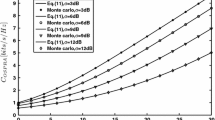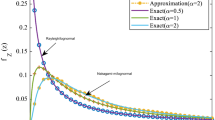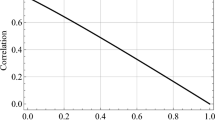Abstract
An approximation method for the cumulative distribution function (CDF) of a signal envelope at the output of an arbitrary radio channel based on the gamma distribution is proposed. The well-known Nakagami approximation method is a special case of the proposed approach. In contrast to the Nakagami method, the convergence of the CDF of some arbitrary non-negative statistics to the proposed asymptotic CDF is presented strictly in the paper and the conditions for this convergence are determined. In addition, the proposed method allows us to take into account the type of the receiving device processing. The use of the proposed approximation is illustrated by the example of a memoryless channel with additive white Gaussian noise, although the possibilities of its application are much wider. We show, that the specificity of a channel model is reduced to a single parameter, called the channel scintillation index. The values of scintillation index for several channel models are calculated, and the error analysis of the proposed CDF approximation is carried out on the basis of them. In the analysis we show, that in the practically significant range of CDF ≥ 0.5, the relative approximation error is within a few percent. The possibility of a relatively simple statistical description of new channel models is illustrated, because their traditional description has significant mathematical difficulties. In particular, a multipath generalization of a TWDP channel model is proposed, called as a MWDP channel.




Similar content being viewed by others
References
S. M. Rytov, Y. A. Kravtsov, V. I. Tatarskii, Principles of Statistical Radiophysics 1 (Springer Berlin Heidelberg, Berlin, Heidelberg, 1987). DOI: https://doi.org/10.1007/978-3-642-69201-7.
D. W. Matolak, J. Frolik, "Worse-than-Rayleigh fading: Experimental results and theoretical models," IEEE Commun. Mag., v.49, n.4, p.140 (2011). DOI: https://doi.org/10.1109/MCOM.2011.5741158.
X. Yin, X. Cheng, Propagation Channel Characterization, Parameter Estimation, and Modeling for Wireless Communications (Wiley-IEEE Press, 2016). URI: https://www.wiley.com/en-us/Propagation+Channel+Characterization%2C+Parameter+Estimation%2C+and+Modeling+for+Wireless+Communications-p-9781118188231.
M. D. Yacoub, "The κ-μ distribution and the η-μ distribution," IEEE Antennas Propag. Mag., v.49, n.1, p.68 (2007). DOI: https://doi.org/10.1109/MAP.2007.370983.
N. Hajri, N. Youssef, T. Kawabata, M. Patzold, W. Dahech, "Statistical properties of double Hoyt fading with applications to the performance analysis of wireless communication systems," IEEE Access, v.6, p.19597 (2018). DOI: https://doi.org/10.1109/ACCESS.2018.2820746.
N. C. Beaulieu, X. Jiandong, "A novel fading model for channels with multiple dominant specular components," IEEE Wirel. Commun. Lett., v.4, n.1, p.54 (2015). DOI: https://doi.org/10.1109/LWC.2014.2367501.
M. K. Samimi, G. R. MacCartney, S. Sun, T. S. Rappaport, "28 GHz millimeter-wave ultrawideband small-scale fading models in wireless channels," in 2016 IEEE 83rd Vehicular Technology Conference (VTC Spring) (IEEE, Washington, 2016). DOI: https://doi.org/10.1109/VTCSpring.2016.7503970.
A. Olutayo, H. Ma, J. Cheng, J. F. Holzman, "Level crossing rate and average fade duration for the Beaulieu-Xie fading model," IEEE Wirel. Commun. Lett., v.6, n.3, p.326 (2017). DOI: https://doi.org/10.1109/LWC.2017.2685506.
U. Karabulut, A. Awada, I. Viering, M. Simsek, G. P. Fettweis, "Spatial and temporal channel characteristics of 5G 3D channel model with beamforming for user mobility investigations," IEEE Commun. Mag., v.56, n.12, p.38 (2018). DOI: https://doi.org/10.1109/MCOM.2018.1800218.
A. Olutayo, J. Cheng, J. F. Holzman, "A new statistical channel model for emerging wireless communication systems," IEEE Open J. Commun. Soc., v.1, p.916 (2020). DOI: https://doi.org/10.1109/OJCOMS.2020.3008161.
J. Huang, Y. Liu, C.-X. Wang, J. Sun, H. Xiao, "5G millimeter wave channel sounders, measurements, and models: Recent developments and future challenges," IEEE Commun. Mag., v.57, n.1, p.138 (2019). DOI: https://doi.org/10.1109/MCOM.2018.1701263.
C. Huang, A. F. Molisch, R. He, R. Wang, P. Tang, Z. Zhong, "Machine-learning-based data processing techniques for vehicle-to-vehicle channel modeling," IEEE Commun. Mag., v.57, n.11, p.109 (2019). DOI: https://doi.org/10.1109/MCOM.001.1900124.
Y. Liu, C.-X. Wang, J. Huang, "Recent developments and future challenges in channel measurements and models for 5G and beyond high-speed train communication systems," IEEE Commun. Mag., v.57, n.9, p.50 (2019). DOI: https://doi.org/10.1109/MCOM.001.1800987.
J. Hu, Z. Zhang, J. Dang, L. Wu, G. Zhu, "Performance of decode-and-forward Relaying in mixed Beaulieu-Xie and $\mathcal{M}$ dual-hop transmission systems with digital coherent detection," IEEE Access, v.7, p.138757 (2019). DOI: https://doi.org/10.1109/ACCESS.2019.2942992.
M. Al-Rawi, M. Al-Rawi, "Performance of massive MIMO uplink system over Nakagami-m fading channel," Radioelectron. Commun. Syst., v.60, n.1, p.13 (2017). DOI: https://doi.org/10.3103/S0735272717010022.
Q. Jing, G. Jinxin, "Study on the dual-orthogonal polarized MIMO wideband satellite mobile channel based on a 4-state LMS model," Radioelectron. Commun. Syst., v.58, n.12, p.551 (2015). DOI: https://doi.org/10.3103/S073527271512002X.
H. L. Van Trees, Detection, Estimation, and Modulation Theory, Part I (Wiley and Sons, New York, 1968).
I. S. Gradshteyn, I. M. Ryzhik, Table of Integrals, Series, and Products (Academic Press, 2007). URI: https://www.academia.edu/36550954/I_S_Gradshteyn_and_I_M_Ryzhik_Table_of_integrals_series_and_products_Academic_Press_2007_.
Y. A. Chernov, Radio-Frequency Propagation and Application Issues (Technosphere, Moscow, 2017).
P. 53.-14 Recommendation, Ionospheric propagation data and prediction methods required for the design of satellite networks and systems (ITU, Geneva, 2019). URI: https://www.itu.int/rec/R-REC-P.531-14-201908-I/en.
G. D. Durgin, T. S. Rappaport, D. A. De Wolf, "New analytical models and probability density functions for fading in wireless communications," IEEE Trans. Commun., v.50, n.6, p.1005 (2002). DOI: https://doi.org/10.1109/TCOMM.2002.1010620.
M. Rao, F. J. Lopez-Martinez, M.-S. Alouini, A. Goldsmith, "MGF approach to the analysis of generalized two-ray fading models," IEEE Trans. Wirel. Commun., p.1 (2015). DOI: https://doi.org/10.1109/TWC.2014.2388213.
T. Q. Duong, H.-J. Zepernick, T. A. Tsiftsis, V. N. Q. Bao, "Amplify-and-forward MIMO Relaying with OSTBC over Nakagami-m fading channels," in 2010 IEEE International Conference on Communications (IEEE, Washington, 2010). DOI: https://doi.org/10.1109/ICC.2010.5501922.
E. Zöchmann, S. Caban, C. F. Mecklenbräuker, S. Pratschner, M. Lerch, S. Schwarz, M. Rupp, "Better than Rician: modelling millimetre wave channels as two-wave with diffuse power," EURASIP J. Wirel. Commun. Netw., v.2019, n.1, p.21 (2019). DOI: https://doi.org/10.1186/s13638-018-1336-6.
Author information
Authors and Affiliations
Corresponding author
Ethics declarations
ADDITIONAL INFORMATION
O. Kaliuzhnyi
The author declares that he has no conflict of interest.
The initial version of this paper in Russian is published in the journal “Izvestiya Vysshikh Uchebnykh Zavedenii. Radioelektronika,” ISSN 2307-6011 (Online), ISSN 0021-3470 (Print) on the link http://radio.kpi.ua/article/view/S002134702012002X with DOI: https://doi.org/10.20535/S002134702012002X
About this article
Cite this article
Kaliuzhnyi, O. Cumulative Distribution Approximation of Signal Envelope in Radio Channels with Arbitrary Scattering. Radioelectron.Commun.Syst. 63, 633–649 (2020). https://doi.org/10.3103/S073527272012002X
Received:
Revised:
Accepted:
Published:
Issue Date:
DOI: https://doi.org/10.3103/S073527272012002X




